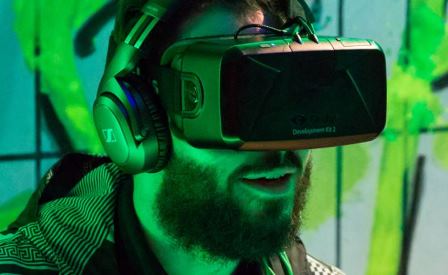Film curator and festival programmer Mathieu Ravier first experienced virtual reality at SXSW in 2013.
"Back then it was pretty crude", Ravier told IF.
"The big breakthrough that was needed to make VR palatable for audiences was to fix a tiny but very significant lag between your head movement and the image following. And that tiny fraction-of-a-second lag would actually make people feel nauseous. That's what happened to me at SXSW when I tried it for the first time."
A few years later and with the technology much improved, VR is coming to the Sydney Film Festival in the form of Down the Rabbit Hole: Virtual Reality at the Hub, a VR sidebar programmed by Ravier at Sydney's Town Hall.
"I think VR technology is coming of age, and it was the right time to bring it into Sydney Film Festival", he said.
"Obviously the festival's been developing its interest in moving image works that sit outside the traditional format of what can be experienced in a cinema. The VR program is part of a wider program called Beyond Cinema that looks at moving image and how that can be experienced differently."
Ravier sees VR as a form on the edge of becoming mainstream.
"I think there's a short window before VR becomes something's that in every household, and I just wanted to create a program that served as a primer or an introduction. Especially looking at the narrative range of VR."
"The tech seems to be catching up with filmmaker's ambitions in terms of storytelling and in parallel I think the work is beginning to catch up to the potential of the medium."
Many have talked about VR as the next evolution of cinema, but the tools used to tell a story are markedly different between the two mediums, according to Ravier.
"One of the things that's apparent to me is that the grammar of filmmaking is very different with VR", he said.
"Firstly by virtue of the fact that there are no edits, everything can be seen, so filmmakers have to hide their crew and there's a certain transparency in terms of film sets and where you're filming that is quite exciting and challenging at the same time."
Without the aid of editing, how does a storyteller working in VR direct their audience's attention?
"Sound is the most important thing in VR", Ravier said.
"It's something that people who haven't tried it don't quite realise. It's where you'll get most of your cues as a viewer for where to look. Having said that, what I do love about VR is that no-one can dictate where you look. Meaning that everyone's experience of the work will be unique. I find that pretty exciting in terms of giving the viewer a new degree of agency."
"As a lover of film, nothing is more of a holy grail than experiencing something with moving image that makes me question my perception of the world and my role within it."


